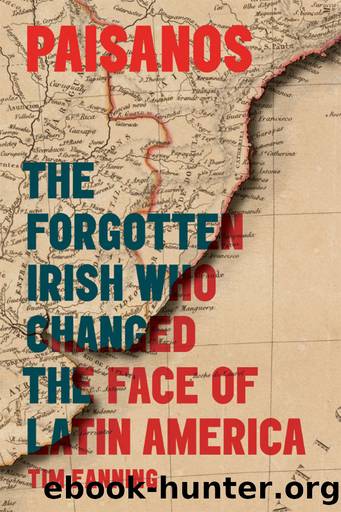Paisanos: The Forgotten Irish Who Changed the Face of Latin America by Tim Fanning

Author:Tim Fanning [Fanning, Tim]
Language: eng
Format: epub
ISBN: 9780717171644
Google: yuu_tAEACAAJ
Publisher: Gill
Published: 2016-09-15T20:40:02+00:00
* Plainsmen or cowboys, from the Spanish word llano, meaning plain.
Chapter 11
THE HIBERNIAN REGIMENT AND THE IRISH LEGION
The regiments that had set sail from Irish and English ports throughout 1817 and 1818 had been thinned by desertion and disease. But, despite the horror stories that were beginning to emerge in the Dublin and London newspapers by courtesy of disgruntled officers such as Henry Croasdaile Wilson and Gustavus Hippisley, Irish volunteers kept arriving in the Caribbean, lured by the promises of unscrupulous recruiters.
Between 1818 and 1820 two Irishmen, Thomas Eyre from County Galway and John Devereux from County Wexford, led recruiting drives for volunteers to serve in BolÃvarâs armies.
Thomas Eyre was the youngest son of Richard and Anchoretta Eyre of Eyrecourt, County Galway. The family were descendants of Cromwellian planters who had settled near Portumna, and Richard Eyre was a former county high sheriff. Thomas Eyre was suffering from financial troubles when he made the acquaintance of Gregor MacGregor, a Scottish soldier who had fought in the Peninsular War. MacGregor had been one of the first European officers to enter the service of the patriot armies in South America and had fought for four years, between 1812 and 1816. Though he seems to have been a capable soldier, he was over-fond of money and drink and was utterly unprincipled. He was a plump, graceful, well-dressed gentleman-soldier who could charm any company and whose military record, at least in the early days of his American adventures, was exemplary. However, his excessive attention to frivolous details â the cut of a uniform, a desire for titles â so beloved of a certain type of eighteenth-century British officer, gave warning of his superficiality; for he was one of the most daring, incorrigible conmen to emerge in the early nineteenth century, a forerunner of a modern property shark.
After his first stint fighting in South America, MacGregor hit on a scheme for selling land in Florida to investors in Savannah, Georgia. With 150 men raised in the United States and the West Indies, MacGregor had landed at Amelia Island near Jacksonville in north-western Florida. Failing to make progress inland, he had set up a government on the island, with himself at its head. When the treasury ran low, he fled to England. He then managed to inveigle £1,000 out of BolÃvarâs agent López Méndez in exchange for raising men and equipment for the patriots. When he failed to make good this promise, López Méndez had him arrested.
Having fallen out with the Venezuelans, MacGregor struck a bargain with an agent by the name of José MarÃa del Real to provide troops for New Granada. It was under MacGregorâs patronage that Eyre began recruiting for what became known as the Regiment of Hibernia or Hibernian Regiment.
Eyreâs competitor, John Devereux, was from Taghmon, County Wexford. He had fought, as a âmere ladâ, in the 1798 Rising; his conduct during the Battle of New Ross was described by the United Irish leader Thomas Cloney as âtruly heroicâ.1 After the rising,
Download
This site does not store any files on its server. We only index and link to content provided by other sites. Please contact the content providers to delete copyright contents if any and email us, we'll remove relevant links or contents immediately.
| Argentina | Bolivia |
| Brazil | Chile |
| Colombia | Ecuador |
| Guyana | Paraguay |
| Peru | Suriname |
| Uruguay | Venezuela |
Cat's cradle by Kurt Vonnegut(15262)
Pimp by Iceberg Slim(14438)
4 3 2 1: A Novel by Paul Auster(12333)
Underground: A Human History of the Worlds Beneath Our Feet by Will Hunt(12054)
The Radium Girls by Kate Moore(11977)
Wiseguy by Nicholas Pileggi(5711)
The Fire Next Time by James Baldwin(5386)
Perfect Rhythm by Jae(5359)
American History Stories, Volume III (Yesterday's Classics) by Pratt Mara L(5276)
Paper Towns by Green John(5141)
Pale Blue Dot by Carl Sagan(4960)
A Higher Loyalty: Truth, Lies, and Leadership by James Comey(4909)
The Mayflower and the Pilgrims' New World by Nathaniel Philbrick(4463)
The Doomsday Machine by Daniel Ellsberg(4452)
Killers of the Flower Moon: The Osage Murders and the Birth of the FBI by David Grann(4410)
The Sympathizer by Viet Thanh Nguyen(4344)
Too Much and Not the Mood by Durga Chew-Bose(4305)
The Borden Murders by Sarah Miller(4278)
Sticky Fingers by Joe Hagan(4148)
